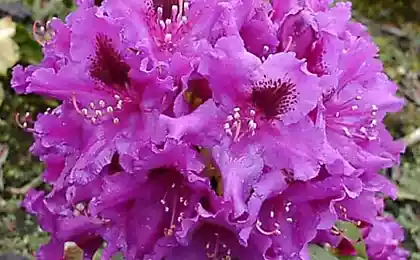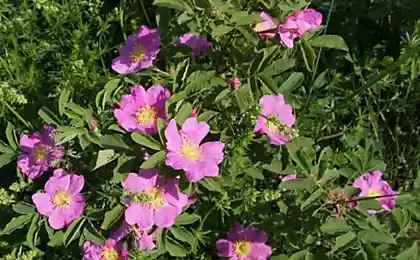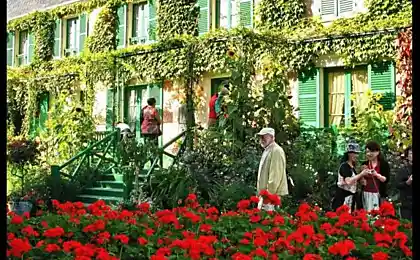506
Mallow and stock-rose: growing and care
The hollyhocks are growing all the same – pink and white.
But on TV you can see that actually their types of a great variety: colorful, plush, with huge flowers.
What is this beauty?
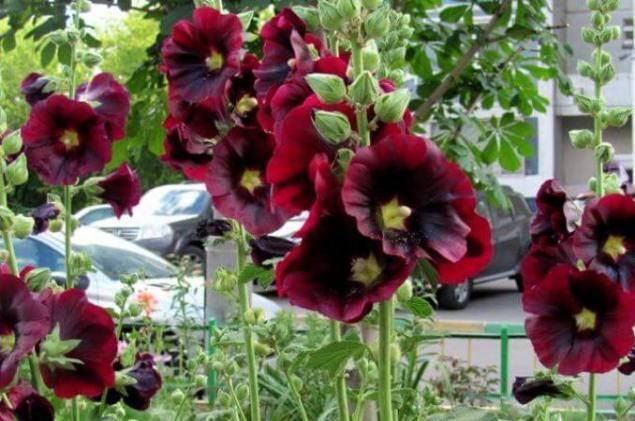
Off-grade stock-rose
The real mallow (Malva alcea) is not very large or double flowers. Although both of these plants belong to the same family – Malvaceae.
Backyards and front gardens are often found not modest mallow, namely off-grade stock-rose with simple light flowers of various colors, which is easily propagated by self-seeding. But her grades are not only a much richer palette, but also the size. For example,the series ‘Halo’ brings together plant with a height of 180 cm and large flowers with a diameter of 10-12 cm in six different shades with a large bright maroon or bright spots in the center. But the cultivar ‘Nigra’ is extremely popular among gardeners because of its unusual dark-chocolate, almost black color.
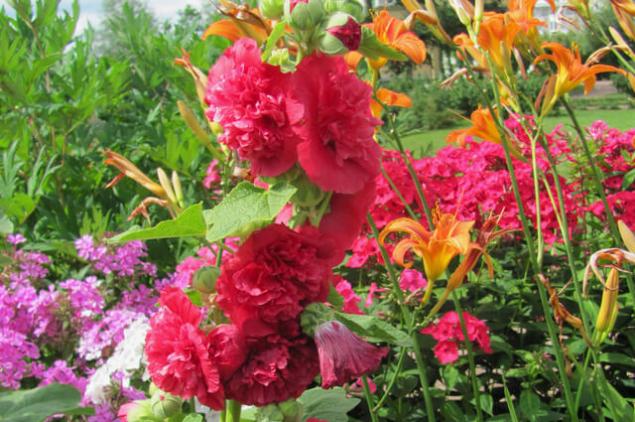
‘Chaters Scarlet’
But still much higher valued-stem roses with double flowers similar to peonies. For example, varieties 'Peaches''n Dreams' they are peach, and 'Appleblossen' – pale pink, "Apple", and on a single stem there may be more than 50 pieces.
And one of the most popular series ‘Chaters’ includes plants with flowers of nine different colors, including elegant, like apricot and purple.
Unfortunately, such beauty need extra care. Plants with heavy double flowers of a much withered away from the wind and the flowers rot when it rains. Therefore, these stem-roses must be tied to a high pole, and fading flowers regularly to remove.
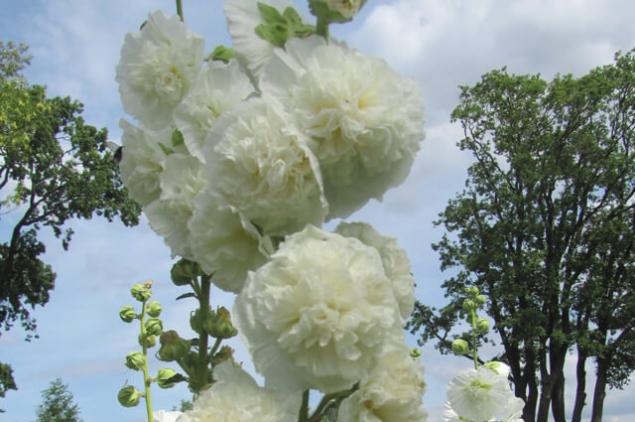
‘Chaters White’
Compared with the usual two-year-old Malva, or stem-rose plants annual shape lower in height so they do not need additional support and are more lush foliage. In addition, they are much less sick with rust. These plants have another advantage – they look great in outdoor containers and pots.
At the annual-stem roses are cartoneria, uniting similar plants with different flower coloring and individual varieties.
The most popular one in recent years was a series of ‘Spring Celebrities’. The height of these plants is only 70 cm They are well branched, giving a powerful stems with attractive foliage. On its background look colorful large semi-double and double flowers of lemon, lilac, Carmine-pink, dark red, pink, purple and white color.
This series is so different from the other varieties-stem roses that in the Latin name for it added the word "annua" (annual).
In the variety ‘Fiesta Time’ unique flowers: double, cherry‑pink with lighter jagged edges of the petals.
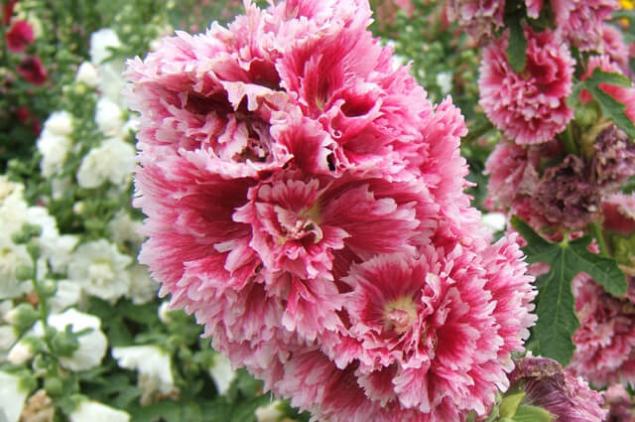
‘Fiesta Time’
Annual grade-stem roses are sown in March – April immediately in pots with a diameter of 10 cm, since the seedlings grow very fast.
Before sowing, the soil is abundantly shed, the seeds are laid out on the surface and sprinkle a layer of soil or vermiculite thickness of about 1 cm
Pots covered with paper and kept at a temperature of 22-23°. After 8-10 days as soon as seeds begin to germinate, expose them to light. The seedlings are kept at a temperature of +18 ...+23 °C and gradually watered when dry topsoil.
It is important to follow the development of the root system. When the roots completely envelop kom and takes the pot, their growth will slow, which will lead to a reduction in the size of the leaves and poor flowering in the summer. If this happens, and before planting in open ground is left for two to three weeks, it is necessary to do handling in larger pots.
A week after handling the seedlings begin to feed complex fertilizers with low phosphorus content. Dose supplements give small, but at every watering.
Also interesting: the Secrets of growing tree peony
How to grow a rose from cut flower
-Stem roses grow well in full sun on nutrient soils without water stagnation. For permanent seedlings planted in mid-may. After planting they should be watered every day for about 10 days to grow roots, and then only in hot weather because they are drought-resistant.
To Jul plants fed complex fertilizers with an interval of 7-10 days. In prolonged wet weather is to remove faded flowers so they do not rot.published
P. S. And remember, only by changing their consumption — together we change the world! ©
Source: nashadacha.info/topics/malva-i-shtok-roza/
But on TV you can see that actually their types of a great variety: colorful, plush, with huge flowers.
What is this beauty?

Off-grade stock-rose
The real mallow (Malva alcea) is not very large or double flowers. Although both of these plants belong to the same family – Malvaceae.
Backyards and front gardens are often found not modest mallow, namely off-grade stock-rose with simple light flowers of various colors, which is easily propagated by self-seeding. But her grades are not only a much richer palette, but also the size. For example,the series ‘Halo’ brings together plant with a height of 180 cm and large flowers with a diameter of 10-12 cm in six different shades with a large bright maroon or bright spots in the center. But the cultivar ‘Nigra’ is extremely popular among gardeners because of its unusual dark-chocolate, almost black color.

‘Chaters Scarlet’
But still much higher valued-stem roses with double flowers similar to peonies. For example, varieties 'Peaches''n Dreams' they are peach, and 'Appleblossen' – pale pink, "Apple", and on a single stem there may be more than 50 pieces.
And one of the most popular series ‘Chaters’ includes plants with flowers of nine different colors, including elegant, like apricot and purple.
Unfortunately, such beauty need extra care. Plants with heavy double flowers of a much withered away from the wind and the flowers rot when it rains. Therefore, these stem-roses must be tied to a high pole, and fading flowers regularly to remove.

‘Chaters White’
Compared with the usual two-year-old Malva, or stem-rose plants annual shape lower in height so they do not need additional support and are more lush foliage. In addition, they are much less sick with rust. These plants have another advantage – they look great in outdoor containers and pots.
At the annual-stem roses are cartoneria, uniting similar plants with different flower coloring and individual varieties.
The most popular one in recent years was a series of ‘Spring Celebrities’. The height of these plants is only 70 cm They are well branched, giving a powerful stems with attractive foliage. On its background look colorful large semi-double and double flowers of lemon, lilac, Carmine-pink, dark red, pink, purple and white color.
This series is so different from the other varieties-stem roses that in the Latin name for it added the word "annua" (annual).
In the variety ‘Fiesta Time’ unique flowers: double, cherry‑pink with lighter jagged edges of the petals.

‘Fiesta Time’
Annual grade-stem roses are sown in March – April immediately in pots with a diameter of 10 cm, since the seedlings grow very fast.
Before sowing, the soil is abundantly shed, the seeds are laid out on the surface and sprinkle a layer of soil or vermiculite thickness of about 1 cm
Pots covered with paper and kept at a temperature of 22-23°. After 8-10 days as soon as seeds begin to germinate, expose them to light. The seedlings are kept at a temperature of +18 ...+23 °C and gradually watered when dry topsoil.
It is important to follow the development of the root system. When the roots completely envelop kom and takes the pot, their growth will slow, which will lead to a reduction in the size of the leaves and poor flowering in the summer. If this happens, and before planting in open ground is left for two to three weeks, it is necessary to do handling in larger pots.
A week after handling the seedlings begin to feed complex fertilizers with low phosphorus content. Dose supplements give small, but at every watering.
Also interesting: the Secrets of growing tree peony
How to grow a rose from cut flower
-Stem roses grow well in full sun on nutrient soils without water stagnation. For permanent seedlings planted in mid-may. After planting they should be watered every day for about 10 days to grow roots, and then only in hot weather because they are drought-resistant.
To Jul plants fed complex fertilizers with an interval of 7-10 days. In prolonged wet weather is to remove faded flowers so they do not rot.published
P. S. And remember, only by changing their consumption — together we change the world! ©
Source: nashadacha.info/topics/malva-i-shtok-roza/

